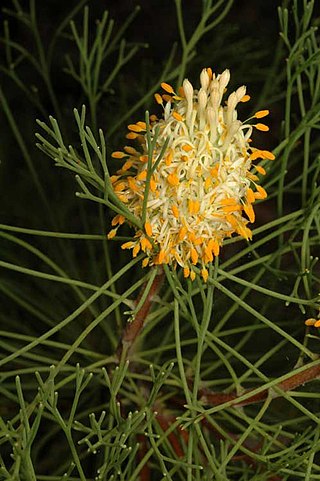
Petrophile pulchella, commonly known as conesticks, is a common shrub of the family Proteaceae and is found in eastern Australia. The leaves are divided with needle-shaped but soft pinnae, the flowers silky-hairy, cream-coloured and arranged in oval heads and the fruit are arranged in oval heads. Conesticks grows on shallow sandstone soils, often in open forest or heathlands near the coast. It is also occasionally seen on the adjacent ranges.

Petrophile pedunculata, commonly known as conesticks, is a species of flowering plant in the family Proteaceae and is endemic to New South Wales. It has divided leaves with needle-shaped pinnae and oval heads of sparsely hairy yellow or cream-coloured flowers, the heads on a peduncle 10–15 mm (0.39–0.59 in) long.

Petrophile anceps is a species of flowering plant in the family Proteaceae and is endemic to a restricted part of the south-west of Western Australia. It is a shrub with sharply-pointed, linear leaves and oval heads of hairy yellow flowers.

Petrophile antecedens is a species of flowering plant in the family Proteaceae and is endemic to the south-west of Western Australia. It is a small, erect, open shrub with sharply-pointed, cylindrical leaves and spherical heads of hairy, pale cream-coloured flowers.

Petrophile brevifolia is a species of flowering plant in the family Proteaceae and is endemic to the south-west of Western Australia. It is a shrub with cylindrical, sharply-pointed leaves, and spherical heads of hairy yellow, cream-coloured or white flowers.
Petrophile chrysantha is a species of flowering plant in the family Proteaceae and is endemic to the south-west of Western Australia. It is a small shrub with crowded, sharply-pointed, pinnately-divided leaves, and oval heads of hairy, cream-coloured to dark yellow flowers.
Petrophile clavata is a species of flowering plant in the family Proteaceae and is endemic to the south-west of Western Australia. It is a shrub with curved, needle-shaped, sharply-pointed leaves and spherical heads of hairy, cream-coloured to very pale yellow flowers.

Petrophile diversifolia is a species of flowering plant in the family Proteaceae and is endemic to southwestern Western Australia. It is a shrub with pinnate, sharply-pointed leaves, and oval heads of densely hairy, white or creamy-white flowers.

Petrophile fastigiata is a species of flowering plant in the family Proteaceae and is endemic to southwestern Western Australia. It is a shrub with pinnately-divided leaves with needle-shaped pinnae and sticky, oval heads of glabrous yellow to cream-coloured flowers.

Petrophile filifolia is a species of flowering plant in the family Proteaceae and is endemic to southwestern Western Australia. It is a small shrub with curved, long, needle-shaped leaves and more or less spherical heads of hairy cream-coloured to pale yellow flowers.

Petrophile heterophylla, commonly known as the variable-leaved conebush, is a species of flowering plant in the family Proteaceae and is endemic to southwestern Western Australia. It is a shrub with variably shaped, sometimes pinnately-divided leaves, and oval heads of silky-hairy, yellow to cream-coloured flowers.
Petrophile incurvata is a species of flowering plant in the family Proteaceae and is endemic to southwestern Western Australia. It is a shrub with flattened, sometimes pinnately-divided leaves with up to five sharply pointed lobes, and cylindrical to oval heads of silky-hairy, cream-coloured to yellowish-white flowers.

Petrophile megalostegia is a species of flowering plant in the family Proteaceae and is endemic to southwestern Western Australia. It is a shrub with needle-shaped or flattened, sometimes S-shaped leaves with a sharply-pointed tip, and more or less cylindrical heads of silky-hairy, yellow to cream-coloured flowers.
Petrophile nivea is a species of flowering plant in the family Proteaceae and is endemic to southwestern Western Australia. It is a small shrub with crowded cylindrical, sharply-pointed leaves and more or less spherical heads of hairy white or cream-coloured flowers on the ends of branchlets.

Petrophile rigida is a species of flowering plant in the family Proteaceae and is endemic to southwestern Western Australia. It is a shrub with rigid, branched, needle-shaped, sharply-pointed leaves, and more or less spherical heads of hairy yellow flowers.

Petrophile squamata is a species of flowering plant in the family Proteaceae and is endemic to the south-west of Western Australia. It is a shrub usually with deeply divided, three-lobed and sharply-pointed leaves, and oval heads of hairy yellow or creamy-yellow flowers.

Petrophile teretifolia is a species of flowering plant in the family Proteaceae and is endemic to the south-west of Western Australia. It is a shrub with needle-shaped but blunt-pointed leaves, and oval to more or less spherical heads of hairy pink to mauve flowers.

Isopogon villosus is a species of flowering plant in the family Proteaceae and is endemic to southwestern Western Australia. It is a tufted shrub with cylindrical leaves with twenty-five to thirty-two widely diverging lobes, and oval heads of cream-coloured to yellow flowers.
Petrophile multisecta, commonly known as Kangaroo Island conesticks, is a species of flowering plant in the family Proteaceae and is endemic to Kangaroo Island in South Australia. It is a prickly shrub with rigid, much-divided leaves with sharply pointed tips, oval to spherical heads of hairy cream-coloured flowers and oval fruit.
Petrophile septemfida is a species of flowering plant in the family Proteaceae and is endemic to southwestern Western Australia. It is a shrub with leaves usually with seven lobes divided almost to the midrid, and spherical heads of cream-coloured to pale yellow flowers on the ends of branchlets.














